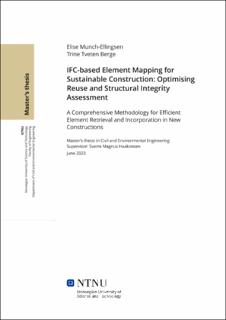| dc.contributor.advisor | Sverre Magnus Haakonsen | |
| dc.contributor.author | Elise Munch-Ellingsen | |
| dc.contributor.author | Trine Tveten Berge | |
| dc.date.accessioned | 2023-09-20T17:20:11Z | |
| dc.date.available | 2023-09-20T17:20:11Z | |
| dc.date.issued | 2023 | |
| dc.identifier | no.ntnu:inspera:146720801:35242350 | |
| dc.identifier.uri | https://hdl.handle.net/11250/3090899 | |
| dc.description.abstract | Bygg- og anleggsindustrien bidrar betydelig til globale klimagassutslipp og miljøforringelse gjennom sine nåværende praksiser. Den dominerende bruk-og-kast tilnærmingen til byggematerialer fører til et høyt energiforbruk og høye utslipp. Med en ventet vekst i byggeproduksjon og derav økt press på materialutvinning- og produksjon, er det er stort behov for å finne mer bærekraftige løsninger som kan lette trykket på en stadig økende material etterspørsel.
Gjenbruk av byggematerialer i nye konstruksjoner kan bidra til å redusere presset på utvinning og produksjon av nye materialer. Likevel, blir gjenbruk svært litt gjennomført i praksis i byggebransjen. Dette skyldes blant annet mangelen på tilstrekkelig god nok kartlegging av eksisterende bygg. Denne masteroppgaven foreslår en metode som bruker IFC filer fra eksisterende bygninger for å hente ut informasjon om tilgjengelige gjenbrukbare byggematerialer. Informasjonen om materialene blir plassert i en database som videre brukes for å evaluere en implementering av elementet i et planlagt prosjekt. Videre blir en grundig strukturell analyse utført av konstruksjonen som blir konstruert av gjenbrukbare elementer for å sikre strukturell integritet. Metoden er basert på en kombinasjon av Python og Grasshopper kode, hvor sistenevne muliggjør visuell fremstilling av resultatene, samt strukturell analyse, på samme plattform. Delmetodene innlemmes i samme programvare, og øker dermed effektiviteten gjennom hele designprosessen. Dette kan bidra til å legge til rette for en mer bærekraftig byggepraksis.
To omfattende case-studier er gjennomført for å vurdere funksjonaliteten, styrkene og svakhetene til den foreslåtte metoden. Resultatene fra case-studiene bekrefter at den presenterte metoden har betydelig potensial for å fremme effektiv gjenbruk av bygningsmaterialer. En vellykket uthenting av strukturelle elementer ble utført basert på IFC-filer, og dannet grunnlaget for en omfattende database med gjenbrukbare elementer. En effektiv kartleggingsprosess av elementer ble gjennomført med mål om å finne strukturelt tilfredsstillende kvaliteter for gjenbruk i en forhåndsdefinert struktur. I Case Study 1 og Case Study 2 fikk den forhåndsdefinerte strukturen dekke behovet for omtrent 90% og 70% av elementene, henholdsvis, gitt en spesifikk database av tilgjengelige og gjenbrukbare elementer. Case-studiene viste en reduksjon på to og syv ganger GWP (Global Warming Potential) og kostnadsøkning på 13% og 33%. En strukturell verifisering ble gjennomført i en FEM analyse, som viste at bruken av de gjenbrukte materialene i den forhåndsdefinerte strukturen var berettiget. | |
| dc.description.abstract | The construction industry significantly contributes to global greenhouse gas emissions and environmental degradation through its current practices. The predominant approach of producing, using, and disposing of construction materials leads to high operational energy consumption and CO2 emissions. The extraction and processing of raw materials further contribute to these emissions. With the projected growth in construction output, there is an urgent need to find solutions that reduce the production of new materials and minimise greenhouse gas emissions.
Reusing components in new constructions reduces the demand for new materials, conserves resources, and minimises the environmental impact associated with material extraction and production. However, the reuse of structural elements in construction projects faces challenges due to the lack of comprehensive inventories of available reusable materials and the inconvenient process of acquiring associated data. To address these challenges, this master's thesis proposes a method that utilises IFC files from existing buildings to extract information for a material database. These materials are then placed in a database and evaluated based on predefined requirements to identify suitable replacements for integration into new structures. This is achieved by the use of Grasshopper. Additionally, a thorough structural analysis is performed directly from the IFC model to ensure the structural integrity of constructions using reused materials. This method integrates the structural analysis seamlessly into the same software used for matching elements through the use of Grasshopper. This facilitates efficient decision-making throughout the design process and encourages a more sustainable construction practice. Reusing components in new constructions reduces the demand for new materials, conserves resources, and minimises the environmental impact associated with material extraction and production.
Two comprehensive case studies have been conducted to assess and evaluate the functionality, strengths, and weaknesses of the proposed method. The findings from the case studies confirmed that the method presented in this master's thesis has significant potential for the efficient reuse of structural elements. A successful material data extraction was performed based on IFC files, laying the foundation for a comprehensive database of reusable elements. An effective mapping process between elements was conducted with the objective to create a predefined structure with the use of reused materials while reducing the cut waste. In Case Study 1 and Case Study 2, the predefined structure successfully fulfilled the demand for approximately 90% and 70% of elements, respectively, given a specific inventory of reusable materials. The case studies proved a reduction of two and seven times the GWP and an increase of cost by 13% and 33%. Through a structural verification conducted using an implemented FEM analysis, it is evident that the utilisation of reused elements in the predefined structures is justified in terms of maintaining structural integrity | |
| dc.language | eng | |
| dc.publisher | NTNU | |
| dc.title | IFC-based Element Mapping for Sustainable Construction: Optimising Reuse and Structural Integrity Assessment | |
| dc.type | Master thesis | |
